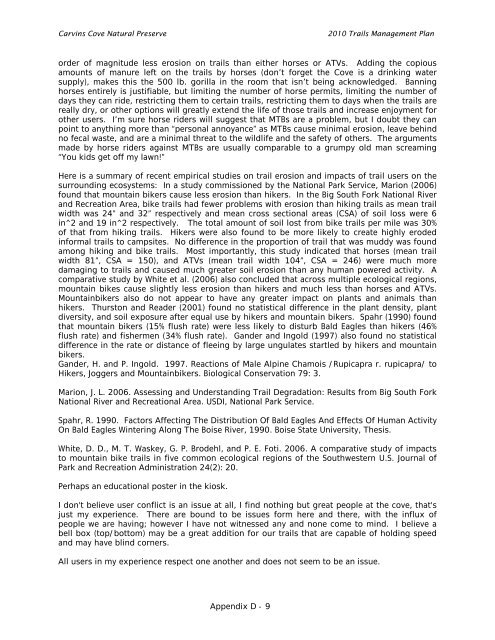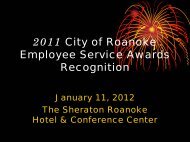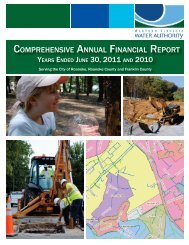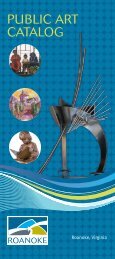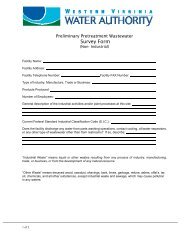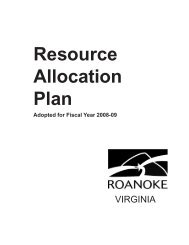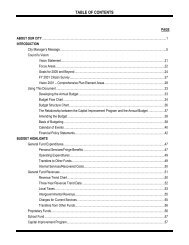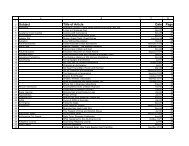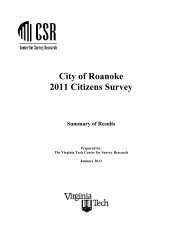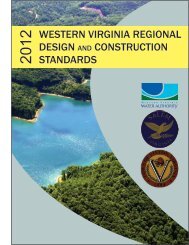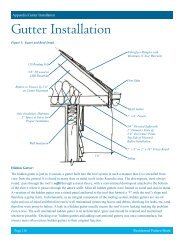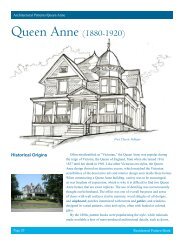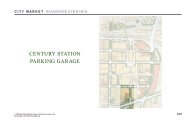Carvins Cove Trail Plan - Roanoke
Carvins Cove Trail Plan - Roanoke
Carvins Cove Trail Plan - Roanoke
Create successful ePaper yourself
Turn your PDF publications into a flip-book with our unique Google optimized e-Paper software.
<strong>Carvins</strong> <strong>Cove</strong> Natural Preserve<br />
2010 <strong>Trail</strong>s Management <strong>Plan</strong><br />
order of magnitude less erosion on trails than either horses or ATVs. Adding the copious<br />
amounts of manure left on the trails by horses (don’t forget the <strong>Cove</strong> is a drinking water<br />
supply), makes this the 500 lb. gorilla in the room that isn’t being acknowledged. Banning<br />
horses entirely is justifiable, but limiting the number of horse permits, limiting the number of<br />
days they can ride, restricting them to certain trails, restricting them to days when the trails are<br />
really dry, or other options will greatly extend the life of those trails and increase enjoyment for<br />
other users. I’m sure horse riders will suggest that MTBs are a problem, but I doubt they can<br />
point to anything more than “personal annoyance” as MTBs cause minimal erosion, leave behind<br />
no fecal waste, and are a minimal threat to the wildlife and the safety of others. The arguments<br />
made by horse riders against MTBs are usually comparable to a grumpy old man screaming<br />
“You kids get off my lawn!”<br />
Here is a summary of recent empirical studies on trail erosion and impacts of trail users on the<br />
surrounding ecosystems: In a study commissioned by the National Park Service, Marion (2006)<br />
found that mountain bikers cause less erosion than hikers. In the Big South Fork National River<br />
and Recreation Area, bike trails had fewer problems with erosion than hiking trails as mean trail<br />
width was 24” and 32” respectively and mean cross sectional areas (CSA) of soil loss were 6<br />
in^2 and 19 in^2 respectively. The total amount of soil lost from bike trails per mile was 30%<br />
of that from hiking trails. Hikers were also found to be more likely to create highly eroded<br />
informal trails to campsites. No difference in the proportion of trail that was muddy was found<br />
among hiking and bike trails. Most importantly, this study indicated that horses (mean trail<br />
width 81”, CSA = 150), and ATVs (mean trail width 104”, CSA = 246) were much more<br />
damaging to trails and caused much greater soil erosion than any human powered activity. A<br />
comparative study by White et al. (2006) also concluded that across multiple ecological regions,<br />
mountain bikes cause slightly less erosion than hikers and much less than horses and ATVs.<br />
Mountainbikers also do not appear to have any greater impact on plants and animals than<br />
hikers. Thurston and Reader (2001) found no statistical difference in the plant density, plant<br />
diversity, and soil exposure after equal use by hikers and mountain bikers. Spahr (1990) found<br />
that mountain bikers (15% flush rate) were less likely to disturb Bald Eagles than hikers (46%<br />
flush rate) and fishermen (34% flush rate). Gander and Ingold (1997) also found no statistical<br />
difference in the rate or distance of fleeing by large ungulates startled by hikers and mountain<br />
bikers.<br />
Gander, H. and P. Ingold. 1997. Reactions of Male Alpine Chamois /Rupicapra r. rupicapra/ to<br />
Hikers, Joggers and Mountainbikers. Biological Conservation 79: 3.<br />
Marion, J. L. 2006. Assessing and Understanding <strong>Trail</strong> Degradation: Results from Big South Fork<br />
National River and Recreational Area. USDI, National Park Service.<br />
Spahr, R. 1990. Factors Affecting The Distribution Of Bald Eagles And Effects Of Human Activity<br />
On Bald Eagles Wintering Along The Boise River, 1990. Boise State University, Thesis.<br />
White, D. D., M. T. Waskey, G. P. Brodehl, and P. E. Foti. 2006. A comparative study of impacts<br />
to mountain bike trails in five common ecological regions of the Southwestern U.S. Journal of<br />
Park and Recreation Administration 24(2): 20.<br />
Perhaps an educational poster in the kiosk.<br />
I don't believe user conflict is an issue at all, I find nothing but great people at the cove, that's<br />
just my experience. There are bound to be issues form here and there, with the influx of<br />
people we are having; however I have not witnessed any and none come to mind. I believe a<br />
bell box (top/bottom) may be a great addition for our trails that are capable of holding speed<br />
and may have blind corners.<br />
All users in my experience respect one another and does not seem to be an issue.<br />
Appendix D - 9


